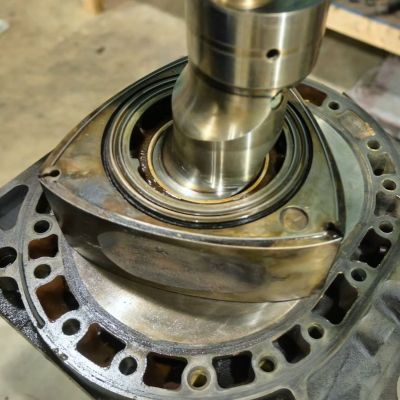
In theory, Wankel-style rotary internal combustion engines have many advantages: they ditch the cumbersome crankcase and piston design, replacing it with a simple, single-chamber design and a thick, plectrum-shaped chunk of metal that spins around inside that chamber to create virtual combustion chambers. This saves weight and maximizes performance-to-weight. Unfortunately, these types of engines are also known for burning a lot of oil and endless seal troubles, especially with early rotary Mazda engines that easily died.
Yet even 1980 versions were not without issues, a case in point is the Mazda 1st gen RX7 with a 12A rotary engine that the [Baked Beans Garage] over at YouTube got their paws on. Starting with unsuccessful attempts to make the car start, the next step was to roll the car into the morgue garage for a full teardown of the clearly deceased engine.
About 35 minutes into the video, we get to the teardown of the engine, with its parts contrasted with those of a newer revision rotary engines alongside illustrations of their functioning, making it as much an autopsy as a detailed introduction to these rotary engines. Technically, they also aren’t the original DKM-style Wankel engines, but a KKM-style engine, as designed by [Hanns-Dieter Paschke]. [Wankel] didn’t like the eccentric KKM design, as he thought it’d put too much stress on the apex seals, but ultimately the more economical KKM design was further developed.
During the autopsy of the 12A revision Mazda engine, it becomes clear that it was likely overheating that killed the engine over the course of years of abuse, along with ‘chatter’ marks of the apex seals destroying the inner chrome coating. This would have compromised compression and with it any chance of the engine running, not unlike a piston engine with badly scored cylinder walls after ingesting some metal chunks.
While the Mazda 12B and subsequent designs addressed many of the issues with the early rotary engines, its use was limited to some sports models, ending in 2012 with the RX-8. The currently produced Mazda MX-30 does use a rotary engine again in its plug-in hybrid version, but it’s only as a range extender engine that drives a generator. Looking at the internals of those Mazda rotary engines, it’s easy to see how complex they are to keep running, but you cannot help but feel a little bit of sadness that these small-but-powerful engines didn’t make much more of a splash.
Continue reading “Autopsy Of A First-Generation RX7 Mazda Rotary Car Engine”













